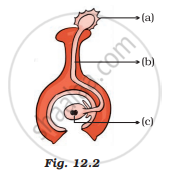Advertisements
Advertisements
Question
In the diagram given in Figure 12.2 label the parts marked (a), (b) and (c).

Solution
In the given diagram
(a) is a pollen grain,
(b) is pollen tube and
(c) is zygote.

APPEARS IN
RELATED QUESTIONS
One of the following organisms does not reproduce by binary fission. This is :
(a) Amoeba
(b) Plasmodium
(c) Leishmania
(d) Paramecium
Complete the following chart:
| Asexual reproduction | Sexual reproduction | ||
| 1. | Reproduction that occurs with the help of somatic cells is called as asexual reproduction. | 1. | ____________ |
| 2. | ____________ | 2. | Male and female parent are necessary for sexual reproduction. |
| 3. | This reproduction occurs with the help of mitosis only. | 3. | ____________ |
| 4 | ____________ | 4. | New individual formed by this method is genetically different from parents. |
| 5 | Asexual reproduction occurs in different individuals by various methods like binary fission, multiple fission, budding, fragmentation, regeneration, vegetative propagation, spore production, etc. | 5. | ____________ |
Explain the term Vegetative propagation.
Grafting is not possible in the monocots because they
Spirogyra reproduce by ______
Many unicellular organisms reproduce by the process of ______
Which of the following statements are true for flowers?
- Flowers are always bisexual
- They are the sexual reproductive organs
- They are produced in all groups of plants
- After fertilisation they give rise to fruits
When one of the following is correctly matched?
Name the asexual reproductive structure of Chlamydomonas.
Suppose there is one member of a particular kind of organism in a culture dish, which doubles itself in one hour through asexual reproduction. Work out the number of members of that kind of organism which will be present in the culture dish after ten hours. Such a colony of individuals arising from one parent is called a “clone”.
